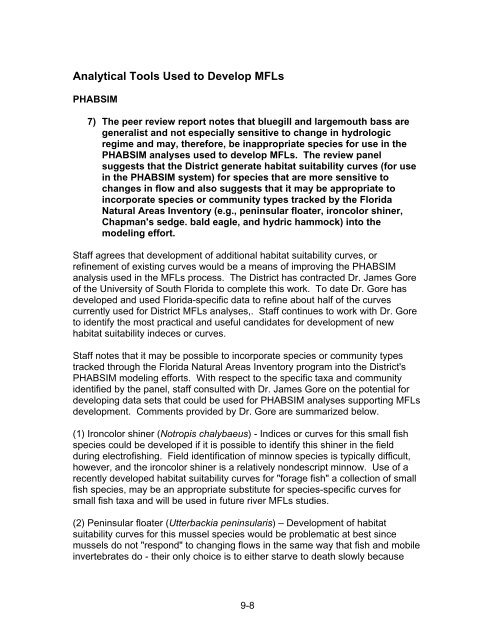Chapter 1 Minimum Flows and Levels - Southwest Florida Water ...
Chapter 1 Minimum Flows and Levels - Southwest Florida Water ...
Chapter 1 Minimum Flows and Levels - Southwest Florida Water ...
You also want an ePaper? Increase the reach of your titles
YUMPU automatically turns print PDFs into web optimized ePapers that Google loves.
Analytical Tools Used to Develop MFLs<br />
PHABSIM<br />
7) The peer review report notes that bluegill <strong>and</strong> largemouth bass are<br />
generalist <strong>and</strong> not especially sensitive to change in hydrologic<br />
regime <strong>and</strong> may, therefore, be inappropriate species for use in the<br />
PHABSIM analyses used to develop MFLs. The review panel<br />
suggests that the District generate habitat suitability curves (for use<br />
in the PHABSIM system) for species that are more sensitive to<br />
changes in flow <strong>and</strong> also suggests that it may be appropriate to<br />
incorporate species or community types tracked by the <strong>Florida</strong><br />
Natural Areas Inventory (e.g., peninsular floater, ironcolor shiner,<br />
Chapman's sedge. bald eagle, <strong>and</strong> hydric hammock) into the<br />
modeling effort.<br />
Staff agrees that development of additional habitat suitability curves, or<br />
refinement of existing curves would be a means of improving the PHABSIM<br />
analysis used in the MFLs process. The District has contracted Dr. James Gore<br />
of the University of South <strong>Florida</strong> to complete this work. To date Dr. Gore has<br />
developed <strong>and</strong> used <strong>Florida</strong>-specific data to refine about half of the curves<br />
currently used for District MFLs analyses,. Staff continues to work with Dr. Gore<br />
to identify the most practical <strong>and</strong> useful c<strong>and</strong>idates for development of new<br />
habitat suitability indeces or curves.<br />
Staff notes that it may be possible to incorporate species or community types<br />
tracked through the <strong>Florida</strong> Natural Areas Inventory program into the District's<br />
PHABSIM modeling efforts. With respect to the specific taxa <strong>and</strong> community<br />
identified by the panel, staff consulted with Dr. James Gore on the potential for<br />
developing data sets that could be used for PHABSIM analyses supporting MFLs<br />
development. Comments provided by Dr. Gore are summarized below.<br />
(1) Ironcolor shiner (Notropis chalybaeus) - Indices or curves for this small fish<br />
species could be developed if it is possible to identify this shiner in the field<br />
during electrofishing. Field identification of minnow species is typically difficult,<br />
however, <strong>and</strong> the ironcolor shiner is a relatively nondescript minnow. Use of a<br />
recently developed habitat suitability curves for "forage fish" a collection of small<br />
fish species, may be an appropriate substitute for species-specific curves for<br />
small fish taxa <strong>and</strong> will be used in future river MFLs studies.<br />
(2) Peninsular floater (Utterbackia peninsularis) – Development of habitat<br />
suitability curves for this mussel species would be problematic at best since<br />
mussels do not "respond" to changing flows in the same way that fish <strong>and</strong> mobile<br />
invertebrates do - their only choice is to either starve to death slowly because<br />
9-8
















